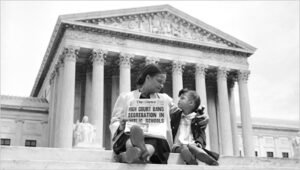New Article on "Brown, Democracy, and Foot Voting"
My contribution to the American Journal of Law and Equality symposium on the 70th anniversary of Brown v. Board of Education.

This year is the 70th anniversary of Brown v. Board of Education, arguably the Supreme Court's most iconic decision. The American Journal of Law and Equality is publishing a symposium on the topic, and I am one of the participants. A draft of my contribution, entitled "Brown, Democracy, and Foot Voting," is now available on SSRN. Here is the abstract:
Traditional assessments of Brown's relationship to democracy and popular control of government should be augmented by considering the ways it enhanced citizens' ability to "vote with their feet" as well as at the ballot box. Brown played a valuable role in reinforcing foot voting, and this has important implications for our understanding of the decision and its legacy.
Part I of the article summarizes the relationship between foot voting and ballot box voting, and how the former has important advantages over the latter as a mechanism of political choice. Relative to ballot box voting, foot voting offers individuals and families greater opportunities to make decisive, well-informed choices. It also has special advantages for minority groups, including Blacks.
Part II considers traditional attempts to reconcile Brown and democracy, through arguments that the decision was actually "representation-reinforcing." While each has its merits, they also have significant limitations. Among other flaws, they often do not apply well to the Brown case itself, which famously originated in a challenge to segregation in Topeka, Kansas, a state in which – unlike most of the South – Blacks had long had the right to vote.
Part III explains how expanding our understanding of Brown to include foot voting opportunities plugs the major holes in traditional efforts to reconcile the decision and democratic choice. Among other advantages, the foot-voting rationale for Brown applies regardless of whether racial minorities have voting rights, regardless of whether segregation laws are motivated by benign or malevolent motives, and regardless of whether the targeted ethnic or racial groups can form political coalitions with others, or not.
In Part IV, I discuss the implications of the foot-voting justification of Brown for judicial review of other policies that inhibit foot voting, particularly in cases where those policies have a history of illicit racial motivations. The most significant of these is exclusionary zoning.
As noted in the article, producing a thesis on Brown that is both new and useful is a tall order. Few if any other judicial decisions have been analyzed so much. But, as the saying goes, "fools rush in where the wise fear to tread." And so I accepted the journal's invitation.
I welcome comments, suggestions, and criticisms.
